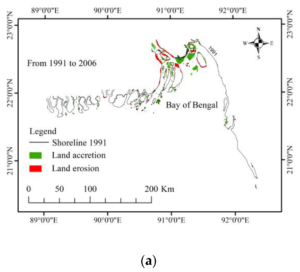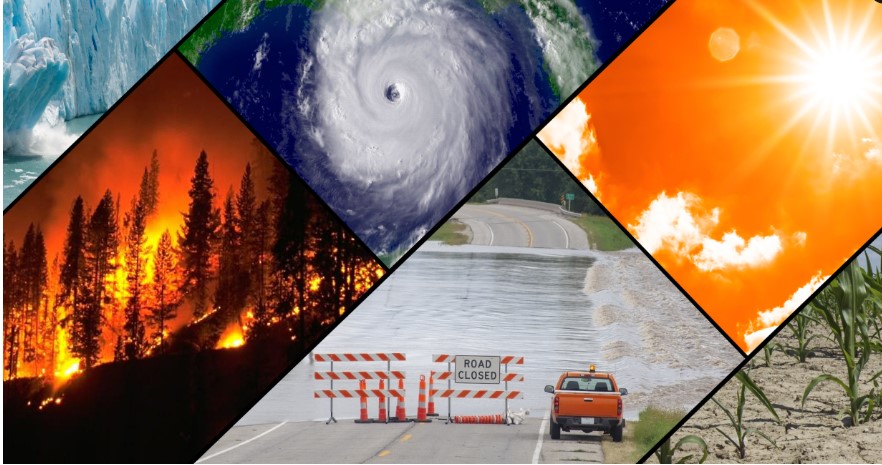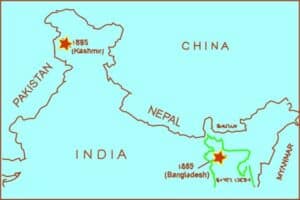Impacts of Climate Change are Slow as Coastal Accretion in Bangladesh is increasing
The impacts of Climate Change in Bangladesh are slowing down as land accretion in Bangladesh is increasing in the southern part of Bangladesh. Recently, a research report published in the peer review journal shows that the net coastal area of Bangladesh is increasing every year.
That means the net coastal area of Bangladesh is added to Bangladesh.
This is good news for the country. The Impacts of Climate Change, as climate change would inundate the coastal land in Bangladesh but the overall process is gaining the land in the coastal area of Bangladesh.
Erosion is one of the processes of loss of land whereas land accretion is the gaining of land. Bangladesh is a deltaic country, hence climate change impacts are much here in Bangladesh.
How are the sediments added to the coastal land in Bangladesh?
The sediments from the Himalayas go down through the river of Padma, Meghna Jamuna, and Brahmaputra and ultimately fall to the Bay of Bengal. The overloaded of sediments causes land accretion in the natural levee of the rivers.
The coastal area of Bangladesh is also gaining land through this process. Because the comparative erosional process is less than the creation process. The research study shows that. Bangladesh is a densely populated country with varied river and delta landscapes.
Bangladesh’s coastal areas are increasing, but rates slowed down in 2006-2021 after the 1991-2006 period. In the 15-year period from 2006 to 2021, the rate of erosion also increased. New coastal land can be added to the Country. This study was important in producing an accurate mapping of the southern parts that are necessary for the respective year.
In this study, they have prepared the coastal boundaries for 1991, 2006, and 2021 as the coastal boundary of the Bay of Bengal country. This research can be used for future Studies and similarly, other researchers can construct shoreline boundaries, including changes over time, for future land-use planning projections.
In the study, the author added that Bangladesh is a Global South hotspot due to climate change and rising sea levels. It is one of the most disaster-prone countries in the world with active delta coasts. Coasts are changing rapidly due to coastal build-up and erosion.
Water hazards for landmass subsidence and accumulation refer to land level rise due to the deposition of sediment loads on the Bay of Bengal continental shelf. Therefore, the study aimed to examine the state of the coast with an assessment of change for Three-year studies in 1991, 2006, and 2021 with the help of the geographic information system and satellite remote sensing (GIS) Landsat 5, 7 ETM+ and 8 OLI satellite imagery were used.
The key finding of the study:
The main finding is that the total recognized land in the coastal zones observed in the periods 1991-2006 was 825.15 km2, 756.69 km2 in 2006-2021, and 1223.94 km2 in 1991-2021 for the period of 30 years. Erosion Assessment Analysis pointed out that the results for the periods 1991-2006 and 2006-2021 were 475.87 km2 and 682.75 km2, respectively.
Therefore, the total coastal erosion from 1991 to 2021 was 800.72 km2.
Net accretion was 73.94 km2 during the 30-year period from 1991 to 2021.
This survey indicates changes in shorelines that reflect evidence of active delta formation through accretion processes and erosion of “climate change” and ” sea level”. rise’.
This research was conducted by Professor Md Shamsuzzoh and Dr. Tofael Ahamed who are currently working in the Graduate School of Life and Environmental Sciences, University of Tsukuba, Tsukuba 305-8577, Japan. Professor Md Shamsuzzoh is a permanent employee at the Patuakhali Science and Technology University, Bangladesh. He is a geographer graduate from Rajshahi University.
The Impacts of Climate Change are huge especially for Bangladesh, because Bangladesh is a coastal country in the world. If there are any climate change impacts,
Bangladesh must face its adverse effects. The research shows us a bit of a positive way about the Impacts of Climate Change, but we should not be happy with this. We must study more about the Impacts of Climate Change and the related issue for our motherland.


5 Impacts of Climate Change
- Rising temperatures: Climate change is leading to increasing global temperatures, resulting in heat waves, droughts, and longer and more intense heat waves. These extreme temperatures can have detrimental effects on human health, agriculture, and natural ecosystems.
- Changing precipitation patterns: Climate change disrupts rainfall patterns, causing more frequent and severe weather events such as hurricanes, storms, and floods. This alteration in precipitation can lead to water scarcity, crop failures, and damage to infrastructure and coastal areas.
- Sea-level rise: As a result of melting ice caps and glaciers, along with the expansion of seawater due to warmer temperatures, sea levels are rising. This poses a significant threat to coastal communities and low-lying islands, increasing the risk of flooding, erosion, and salinization of freshwater sources.
- Biodiversity loss: Climate change is causing shifts in ecosystems and habitats, resulting in the loss of biodiversity. Species are struggling to adapt to rapidly changing conditions, leading to disruptions in food webs, reduced habitat availability, and an increased risk of extinction for many plant and animal species.
- Impacts on human health: Climate change contributes to various health risks, including increased occurrences of vector-borne diseases (such as malaria and dengue fever), respiratory illnesses due to worsening air quality, and heat-related illnesses and deaths. Vulnerable populations, such as the elderly, children, and those in poverty, are particularly at risk.
4 Main Impacts of Climate Change
- Extreme weather events: Climate change is leading to more frequent and intense weather events, including hurricanes, storms, floods, and heat waves. These events can result in significant damage to infrastructure, displacement of communities, and loss of lives.
- Water scarcity: Climate change affects the availability and distribution of water resources. Changes in precipitation patterns can lead to droughts in some regions, causing water scarcity for agriculture, drinking water supplies, and industrial use.
- Agricultural disruptions: Climate change impacts agricultural systems through shifts in temperature, rainfall patterns, and increased occurrence of pests and diseases. These changes can reduce crop yields, damage livestock production, and negatively affect food security and rural livelihoods.
- Ecosystem disruption: Climate change alters ecosystems by affecting temperature, rainfall, and the timing of natural events such as flowering, migration, and hibernation. These disruptions can result in habitat loss, species extinctions, and imbalances in ecosystems, with cascading effects on biodiversity and ecosystem services.
Effects of Climate Change
- Melting glaciers and ice caps: Rising temperatures cause the melting of glaciers and ice caps worldwide, contributing to sea-level rise and the loss of freshwater resources.
- Ocean acidification: Increased carbon dioxide (CO2) emissions from human activities are absorbed by the oceans, leading to ocean acidification. This acidification poses a significant threat to marine life, including coral reefs and shellfish, which rely on carbonate ions to build their shells and skeletons.
- Increased forest fires: Climate change creates drier conditions and increases the frequency and intensity of wildfires in many regions. These fires not only destroy forests but also release large amounts of carbon dioxide into the atmosphere, exacerbating climate change.
- Threats to coastal areas: Rising sea levels and more frequent storms put coastal areas at risk of erosion, flooding, and salinization of freshwater sources. Many coastal communities and ecosystems face the threat of displacement and habitat loss.
- Declining biodiversity: Climate change disrupts ecosystems and threatens biodiversity. Changes in temperature, precipitation, and habitat conditions can lead to species extinctions and loss of critical ecosystem services.
- Economic impacts: Climate change has significant economic consequences, including damage to infrastructure, increased costs for disaster response and recovery, and loss of livelihoods in sectors such as agriculture, fishing, and tourism.
- Social and political instability: Climate change exacerbates existing social and political tensions, particularly in regions already facing resource scarcity and environmental degradation. Displacement, conflicts over natural resources, and migration pressures can lead to social unrest and political instability.
Climate change has numerous impacts on agriculture, including:
- Shifts in growing seasons: Changes in temperature and precipitation patterns can disrupt traditional growing seasons, affecting crop growth and yields.
- Water scarcity: Changes in rainfall patterns can lead to droughts, reducing water availability for irrigation and livestock farming.
- Increased pests and diseases: Warmer temperatures can contribute to the proliferation of pests and diseases, damaging crops and reducing agricultural productivity.
- Reduced crop yields: Extreme weather events, such as storms, floods, and heat waves, can damage crops, leading to decreased yields and potential food shortages.
- Changes in pest and weed dynamics: Climate change alters the behavior and distribution of pests and weeds, requiring adjustments in pest control strategies.
Impacts of Climate Change on Human Health
Climate change affects human health in various ways, including:
- Heat-related illnesses: Rising temperatures increase the risk of heatstroke, heat exhaustion, and other heat-related illnesses, especially among vulnerable populations.
- Increased vector-borne diseases: Changing climate conditions expand the range and transmission seasons of disease-carrying vectors such as mosquitoes and ticks, leading to a higher incidence of diseases like malaria, dengue fever, and Lyme disease.
- Respiratory problems: Poor air quality resulting from increased air pollution, pollen, and allergens exacerbate respiratory conditions like asthma and allergies.
- Waterborne diseases: Changes in precipitation patterns and water quality can contribute to the spread of waterborne diseases such as cholera and diarrhea.
- Mental health impacts: Climate-related events like natural disasters and displacement can lead to psychological distress, anxiety, and post-traumatic stress disorder (PTSD).
Impacts of Climate Change in the UK
Climate change impacts in the UK include:
- Increased flooding: Rising sea levels and heavier rainfall increase the risk of flooding in coastal and low-lying areas, leading to property damage and displacement.
- Erosion and coastal damage: Sea-level rise and increased storm activity accelerate erosion along the coast, endangering infrastructure and habitats.
- Water scarcity: Changes in rainfall patterns and increased evaporation can lead to water scarcity, particularly in the summer months, affecting agriculture and water supplies.
- Changes in ecosystems: Climate change disrupts ecosystems, impacting biodiversity, wildlife habitats, and plant species distribution.
- Health risks: Heatwaves and extreme weather events pose health risks to the population, particularly the elderly and those with pre-existing health conditions.
Impacts of Climate Change in Africa
Climate change impacts in Africa include:
- Food security challenges: Changes in rainfall patterns and increased frequency of droughts affect agricultural productivity and food security, leading to hunger and malnutrition.
- Water stress: Climate change exacerbates water scarcity issues, particularly in arid and semi-arid regions, affecting access to clean drinking water and agriculture.
- Increased frequency and intensity of extreme weather events: Africa is prone to floods, droughts, and storms, which are becoming more severe and frequent due to climate change, resulting in loss of life, displacement, and damage to infrastructure.
- Threats to biodiversity: Climate change poses a significant threat to Africa’s rich biodiversity, including iconic species like elephants and rhinos, leading to habitat loss and potential extinction.
- Health impacts: Climate change contributes to the spread of diseases like malaria, cholera, and meningitis, and can worsen existing health challenges, including malnutrition and respiratory diseases.
Impacts of Climate Change in Australia
Climate change impacts in Australia include:
- Increased frequency and intensity of bushfires: Rising temperatures and drier conditions contribute to more frequent and severe bushfires, resulting in loss of life, destruction of homes, and damage to ecosystems.
- Water scarcity and drought: Climate change exacerbates water scarcity and drought conditions, affecting agricultural production, water supplies, and ecosystems.
- Coral reef bleaching: Warmer ocean temperatures cause coral bleaching events, leading to the degradation of the Great Barrier Reef and other important marine ecosystems.
- Heatwaves and health risks: Australia experiences more frequent and prolonged heatwaves, posing health risks, particularly for vulnerable populations and outdoor workers.
- Changes in ecosystems and biodiversity: Climate change impacts Australia’s unique ecosystems and biodiversity, including shifts in species distribution, loss of habitat, and increased threats to vulnerable species.
Impacts of Climate Change in the Philippines
Climate change impacts in the Philippines include:
- Increased frequency and intensity of typhoons: Climate change contributes to more intense and destructive typhoons, resulting in widespread damage, loss of life, and displacement.
- Sea-level rise and coastal erosion: Rising sea levels threaten coastal communities, leading to increased erosion, flooding, and saltwater intrusion into freshwater sources.
- Water scarcity and drought: Changes in rainfall patterns and prolonged dry spells affect water availability for agriculture, drinking water supplies, and hydropower generation.
- Agriculture and food security challenges: Climate change affects crop yields, agricultural productivity, and fishery resources, posing risks to food security and livelihoods.
- Health impacts: Climate change contributes to the spread of diseases such as dengue fever and waterborne illnesses, and increases the vulnerability of communities to heat-related illnesses.
Impacts of Climate Change on Biodiversity
Climate change has significant impacts on biodiversity, including:
- Habitat loss and fragmentation: Changing climatic conditions disrupt ecosystems and habitats, leading to the loss of suitable environments for many plant and animal species.
- Species extinctions: Climate change exacerbates existing threats to vulnerable species, increasing the risk of extinction.
- Altered species interactions: Climate change can disrupt ecological relationships, such as pollination and predator-prey dynamics, affecting the balance and functioning of ecosystems.
- Range shifts and migration: Species are forced to shift their ranges or migrate to more suitable environments as their current habitats become less favorable, which can lead to conflicts with existing ecosystems and human activities.
- Disruption of ecosystem services: Biodiversity loss due to climate change affects critical ecosystem services such as pollination, nutrient cycling, and water purification, impacting the overall functioning and resilience of ecosystems.
Impacts of Climate Change in Pakistan
Climate change impacts in Pakistan include:
- Glacial melting and water availability: Glaciers in the Himalayas are melting at an accelerated rate, affecting water availability for agriculture, drinking water, and hydropower generation.
- Increased frequency and intensity of heatwaves: Rising temperatures contribute to more frequent and severe heatwaves, posing health risks and impacting vulnerable populations.
- Changing rainfall patterns and water scarcity: Climate change disrupts rainfall patterns, leading to water scarcity, droughts, and reduced agricultural productivity.
- Floods and extreme weather events: Climate change increases the risk of floods and extreme weather events, causing damage to infrastructure, loss of lives, and displacement of communities.
- Agricultural disruptions: Changes in temperature and rainfall patterns affect crop yields and agricultural productivity, threatening food security and rural livelihoods.
Economic Impacts of Climate Change
Climate change has significant economic impacts, including:
- Damage to infrastructure: Extreme weather events and rising sea levels can damage infrastructure such as roads, bridges, buildings, and coastal facilities, requiring costly repairs and reconstruction.
- Increased healthcare costs: Climate change-related health impacts, such as heat-related illnesses and vector-borne diseases, can result in higher healthcare costs for individuals and governments.
- Losses in agriculture and fisheries: Climate change affects agricultural productivity and fishery resources, leading to crop failures, reduced yields, and income losses for farmers and fishermen.
- Impact on tourism and recreation: Changing climate conditions can affect tourism-dependent economies, as attractions like beaches, coral reefs, and natural landscapes may suffer from degradation or loss.
- Insurance and financial sector risks: Climate change-related risks, including property damage from extreme weather events, pose challenges for the insurance and financial sectors, potentially leading to increased premiums and reduced investment.
Social Impacts of Climate Change
Climate change has various social impacts, including:
- Displacement and migration: Rising sea levels, extreme weather events, and the degradation of land and resources can force communities to relocate, leading to internal and cross-border migration and potential conflicts.
- Threats to human settlements: Coastal communities and low-lying areas are particularly vulnerable to sea-level rise, flooding, and erosion, resulting in the loss of homes, infrastructure, and cultural heritage.
- Health inequalities: Climate change disproportionately affects vulnerable populations, exacerbating existing health inequalities based on socioeconomic status, age, gender, and location.
- Social unrest and conflicts: Climate change-induced resource scarcity, displacement, and competition can contribute to social unrest and conflicts over land, water, and other natural resources.
- Cultural impacts: Climate change can impact cultural practices, traditional knowledge systems, and cultural heritage, affecting the identity and well-being of indigenous communities and marginalized groups.
Positive Impacts of Climate Change
While the negative impacts of climate change are significant, it is important to note that there are a few positive impacts, such as:
- Longer growing seasons: In certain regions, warmer temperatures and extended growing seasons can provide opportunities for increased agricultural productivity and diversification of crops.
- Increased renewable energy adoption: The urgency to combat climate change has accelerated the adoption of renewable energy sources, leading to advancements in clean technologies and creating new jobs in the renewable energy sector.
- Expanded access to resources: Melting ice in polar regions may open up new shipping routes and access to natural resources previously inaccessible, potentially benefitting certain industries and economies.
- Enhanced carbon dioxide fertilization effect: Increased carbon dioxide levels can promote photosynthesis and potentially enhance plant growth and agricultural productivity in some regions.
It is important to note that these potential positive impacts are outweighed by the significant negative consequences of climate change.
Negative Impacts of Climate Change
Climate change has numerous negative impacts, including:
- Increased frequency and intensity of extreme weather events: Heatwaves, storms, floods, and droughts are becoming more frequent and severe, leading to property damage, loss of lives, and displacement of communities.
- Rising sea levels: Melting ice caps and thermal expansion of seawater contribute to rising sea levels, threatening coastal communities, ecosystems, and infrastructure with flooding, erosion, and saltwater intrusion.
- Loss of biodiversity: Climate change disrupts ecosystems, leading to habitat loss, species extinctions, and imbalances in ecosystems, with cascading effects on biodiversity and ecosystem services.
- Water scarcity and drought: Changes in rainfall patterns and increased evaporation rates contribute to water scarcity, affecting agriculture, drinking water supplies, and ecosystems.
- Health risks: Climate change contributes to the spread of vector-borne diseases, heat-related illnesses, respiratory problems due to air pollution, and mental health impacts caused by extreme weather events and displacement.
- Agricultural disruptions: Changes in temperature, rainfall patterns, and the increased occurrence of pests and diseases can reduce crop yields, damage livestock production, and threaten food security and rural livelihoods.
- Economic costs: Climate change leads to significant economic costs due to property damage, increased healthcare expenses, loss of agricultural productivity, disrupted supply chains, and impacts on industries such as tourism and insurance.
Environmental Impacts of Climate Change
Climate change has significant environmental impacts, including:
- Melting glaciers and polar ice: Rising temperatures contribute to the melting of glaciers and polar ice caps, leading to rising sea levels and loss of critical freshwater sources.
- Changes in ecosystems: Climate change disrupts ecosystems and habitats, affecting plant and animal species’ distribution, migration patterns, and interactions, leading to biodiversity loss.
- Ocean acidification: Increased carbon dioxide emissions are absorbed by the oceans, resulting in ocean acidification, which has adverse effects on marine life, particularly coral reefs, shellfish, and other calcifying organisms.
- Disruption of marine ecosystems: Warming oceans and changing currents affect marine ecosystems, including the distribution and abundance of fish and other marine species, with implications for fisheries and food security.
- Loss of coastal ecosystems: Rising sea levels and increased storm surges threaten coastal ecosystems such as mangroves, salt marshes, and seagrass beds, which provide critical habitats, storm protection, and carbon storage.
- Deforestation and forest degradation: Climate change exacerbates the pressures on forests, leading to deforestation, forest fires, and degradation, which contribute to carbon emissions and the loss of biodiversity.
- Increased air pollution: Climate change can worsen air quality through increased wildfires, dust storms, and the formation of ground-level ozone, negatively impacting human health and ecosystems.
Political Impacts of Climate Change
Climate change has political impacts at various levels, including:
- International cooperation and agreements: Climate change necessitates global cooperation and the negotiation of international agreements such as the Paris Agreement to mitigate greenhouse gas emissions and address adaptation.
- Policy and regulation: Governments develop policies and regulations to reduce greenhouse gas emissions, promote renewable energy, and adapt to the impacts of climate change.
- Resource conflicts and geopolitical tensions: Climate change-induced resource scarcity, particularly water and arable land, can lead to conflicts and tensions between nations, especially in regions with existing political instabilities.
- Migration and refugee challenges: Climate change-related displacement and migration can strain political systems and create challenges for receiving countries, leading to debates on immigration policies and humanitarian responses.
- Public opinion and activism: Climate change has become a prominent issue in public discourse, leading to increased awareness, activism, and demands for political action and accountability.
Global Impacts of Climate Change
Climate change has global impacts, including:
- Rising temperatures: Average global temperatures are increasing, leading to a wide range of interconnected impacts on ecosystems, weather patterns, and human well-being.
- Sea-level rise: Global sea levels are rising due to the thermal expansion of seawater and the melting of ice caps and glaciers, threatening coastal areas and small island nations.
- Changing precipitation patterns: Climate change alters rainfall patterns, leading to droughts in some regions and increased precipitation and floods in others, impacting water availability, agriculture, and ecosystems.
- Loss of biodiversity and ecosystems: Climate change poses a significant threat to global biodiversity, leading to species extinctions, habitat loss, and imbalances in ecosystems.
- Migration and displacement: Climate change-induced events, such as extreme weather events and sea-level rise, can force people to migrate and displace, affecting both receiving and sending communities.
- Economic and social inequality: Climate change disproportionately affects vulnerable communities, exacerbating existing economic and social inequalities within and between countries.
- Transboundary impacts: Climate change does not respect national borders, and its impacts can transcend political boundaries, requiring international cooperation and coordination to address shared challenges.
What are Some Impacts of Climate Change?
Some impacts of climate change include:
- Increased frequency and intensity of extreme weather events, such as storms, heatwaves, floods, and droughts.
- Rising sea levels lead to coastal erosion, flooding, and the displacement of coastal communities.
- Changes in precipitation patterns resulted in water scarcity in some regions and increased rainfall and floods in others.
- Loss of biodiversity and habitat degradation, endangering plant and animal species and disrupting ecosystems.
- Agricultural disruptions include reduced crop yields, loss of livestock, and threats to food security.
- Health risks, include heat-related illnesses, the spread of vector-borne diseases, and worsened air quality.
- Economic costs, such as damage to infrastructure, increased healthcare expenses, and losses in industries like agriculture and tourism.
- Social impacts include displacement, migration, conflicts over resources, and disproportionate effects on vulnerable populations.
Impacts and How to Reduce the Effects of Climate Change
To reduce the effects of climate change, some strategies include:
- Mitigating greenhouse gas emissions: Transitioning to renewable energy sources, improving energy efficiency, and adopting sustainable practices in sectors such as transportation, industry, and agriculture.
- Adapting to climate change: Developing and implementing adaptation strategies to reduce vulnerabilities, enhance resilience, and protect communities and ecosystems from climate impacts.
- Conserving and restoring ecosystems: Protecting forests, wetlands, and other natural habitats, as well as restoring degraded ecosystems, to enhance carbon sequestration, preserve biodiversity, and improve ecosystem services.
- Sustainable land and water management: Promoting sustainable agriculture practices, efficient irrigation systems, and responsible land use to conserve resources, reduce emissions, and enhance resilience.
- Raising awareness and education: Increasing public awareness about climate change, its impacts, and the importance of individual and collective actions to mitigate and adapt to its effects.
- International cooperation: Strengthening global cooperation, knowledge sharing, and funding mechanisms to support climate change mitigation and adaptation efforts, particularly in developing countries.
- Policy and regulation: Implementing comprehensive and ambitious climate policies, including carbon pricing, regulations, and incentives, to drive emissions reductions and sustainable practices at national and international levels.
Impacts and Causes of Climate Change
The impacts of climate change are primarily caused by:
- Greenhouse gas emissions: The release of greenhouse gases, primarily carbon dioxide (CO2), methane (CH4), and nitrous oxide (N2O), from human activities, including the burning of fossil fuels, deforestation, and industrial processes.
- Deforestation and land-use changes: Clearing forests for agriculture, urbanization, and other purposes reduces the Earth’s capacity to absorb CO2 and disrupts ecosystems.
- Agricultural practices: Intensive livestock farming, rice cultivation, and the use of synthetic fertilizers contribute to greenhouse gas emissions, particularly methane and nitrous oxide.
- Industrial processes: Industrial activities, such as energy production, manufacturing, and cement production, release substantial amounts of CO2 and other greenhouse gases.
- Waste management: Improper waste disposal and decomposition of organic waste in landfills produce methane emissions.
- Transportation: The burning of fossil fuels in vehicles for transportation is a significant source of CO2 emissions.
- Changes in land and water use: Altering natural landscapes, draining wetlands, and modifying water systems contribute to the release of greenhouse gases and disrupt ecosystems.





